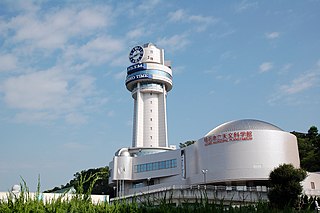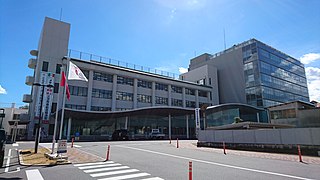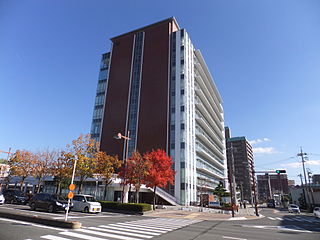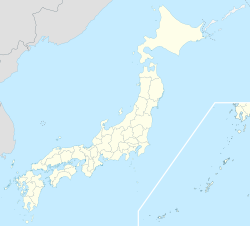
Hiroshima Prefecture is a prefecture of Japan located in the Chūgoku region of Honshu. Hiroshima Prefecture has a population of 2,811,410 and has a geographic area of 8,479 km². Hiroshima Prefecture borders Okayama Prefecture to the east, Tottori Prefecture to the northeast, Shimane Prefecture to the north, and Yamaguchi Prefecture to the southwest.

Himeji is a city located in Hyōgo Prefecture in the Kansai region of Japan. As of 1 June 2022, the city had an estimated population of 525,682 in 227,099 households and a population density of 980 persons per km2. The total area of the city is 534.35 square kilometres (206.31 sq mi).

Akashi is a city in southern Hyōgo Prefecture, Japan. As of 1 February 2024, the city had an estimated population of 305,925 in 137,288 households and a population density of 6,200 people per km2. The total area of the city is 49.42 square kilometres (19.08 sq mi).

Takehara is a city located in Hiroshima Prefecture, Japan. As of 30 April 2023, the city had an estimated population of 23,350 in 12034 households and a population density of 200 persons per km2. The total area of the city is 118.23 square kilometres (45.65 sq mi).

Onomichi is a city located in Hiroshima Prefecture, Japan.

Miyoshi is a city located in Hiroshima Prefecture, Japan. As of 31 March 2023, the city had an estimated population of 49,106 in 23154 households and a population density of 63 persons per km². The total area of the city is 778.14 square kilometres (300.44 sq mi).

Ōtake is a city located in Hiroshima Prefecture, Japan. As of 1 June 2023, the city had an estimated population of 25,955 in 12884 households and a population density of 330 persons per km². The total area of the city is 78.66 square kilometres (30.37 sq mi).

Higashihiroshima is a city located in Hiroshima Prefecture, Japan. As of 30 April 2023, the city had an estimated population of 190,186 in 90,294 households and a population density of 300 persons per km2. The total area of the city is 635.16 square kilometres (245.24 sq mi).

Hatsukaichi is a city located in Hiroshima Prefecture, Japan. As of 1 May 2023, the city had an estimated population of 116,087 in 53320 households and a population density of 240 persons per km2. The total area of the city is 489.48 square kilometres (188.99 sq mi).

Toyota is a district located in Hiroshima Prefecture, Japan. Currently the district has only the town of Ōsakikamijima.
Mitsugi was a district in Hiroshima Prefecture, Japan.

Sera is a town located in Sera District, Hiroshima Prefecture, Japan. As of 31 March 2023, the town had an estimated population of 15,070 in 6809 households and a population density of 63 persons per km2. The total area of the town is 278.14 square kilometres (107.39 sq mi).

The Kure Line is a railway line operated by West Japan Railway Company within Hiroshima Prefecture in Japan. It begins at Mihara Station in Mihara and terminates at Kaitaichi Station in Kaita. It is one of the main lines of JR West. The section between Mihara Station to Hiro Station is branded the "Setouchi Sazanami Line" as the sightseeing line. On the section between Mihara Station and Hiro Station, most trains operate from Hiro Station through Mihara Station to Itozaki Station. On the section between Hiro Station and Kaitaichi Station, most trains operate from Hiro Station through Kaitaichi Station to Hiroshima Station or Iwakuni Station.

Mihara Castle was a hirajiro-style Japanese castle located in what is today the city of Mihara in Hiroshima Prefecture. Its ruins have been protected by the central government as a National Historic Site since 1957.

Onomichi Station is a passenger railway station located in the city of Onomichi, Hiroshima Prefecture, Japan. It is operated by the West Japan Railway Company.

Itozaki Station is a passenger railway station located in the city of Mihara, Hiroshima Prefecture, Japan. It is operated by the West Japan Railway Company. It is also a freight depot for the Japan Freight Railway Company

Mihara Station is a passenger railway station located in the city of Mihara, Hiroshima Prefecture, Japan. It is operated by the West Japan Railway Company. It is also a freight depot for the Japan Freight Railway Company

Hachihommatsu Station is a passenger railway station located in the city of Higashihiroshima, Hiroshima Prefecture, Japan. It is operated by the West Japan Railway Company.

Niitakayama Castle of Aki Province was a yamajiro-style Japanese castle located in what is today the Hongō neighborhood of the city of Mihara in Hiroshima Prefecture. Its ruins have been protected by the central government as a National Historic Site since 1957.

Takayama Castle of Aki Province was a yamajiro-style Japanese castle located in what is today the Hongō neighborhood of the city of Mihara in Hiroshima Prefecture. Its ruins have been protected by the central government as a National Historic Site since 1957.





























